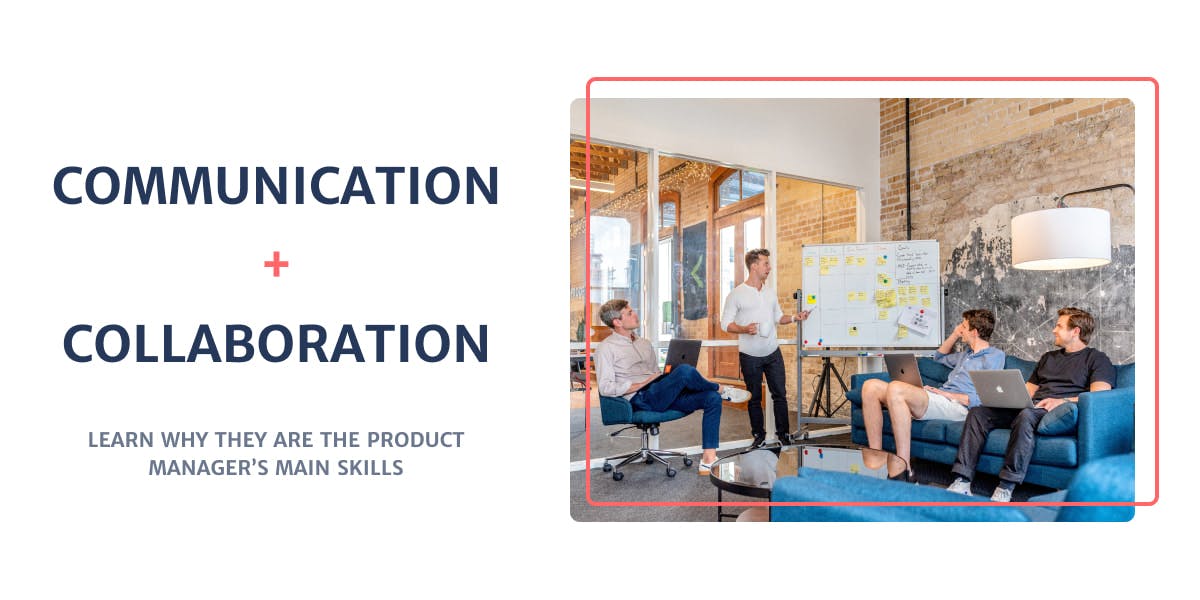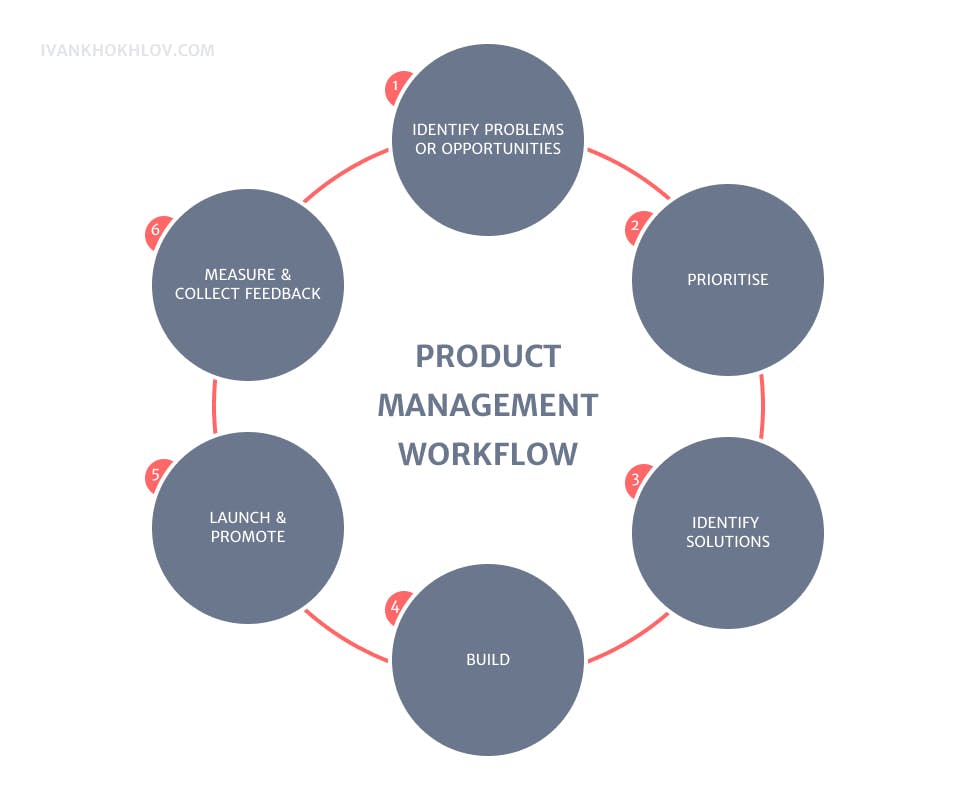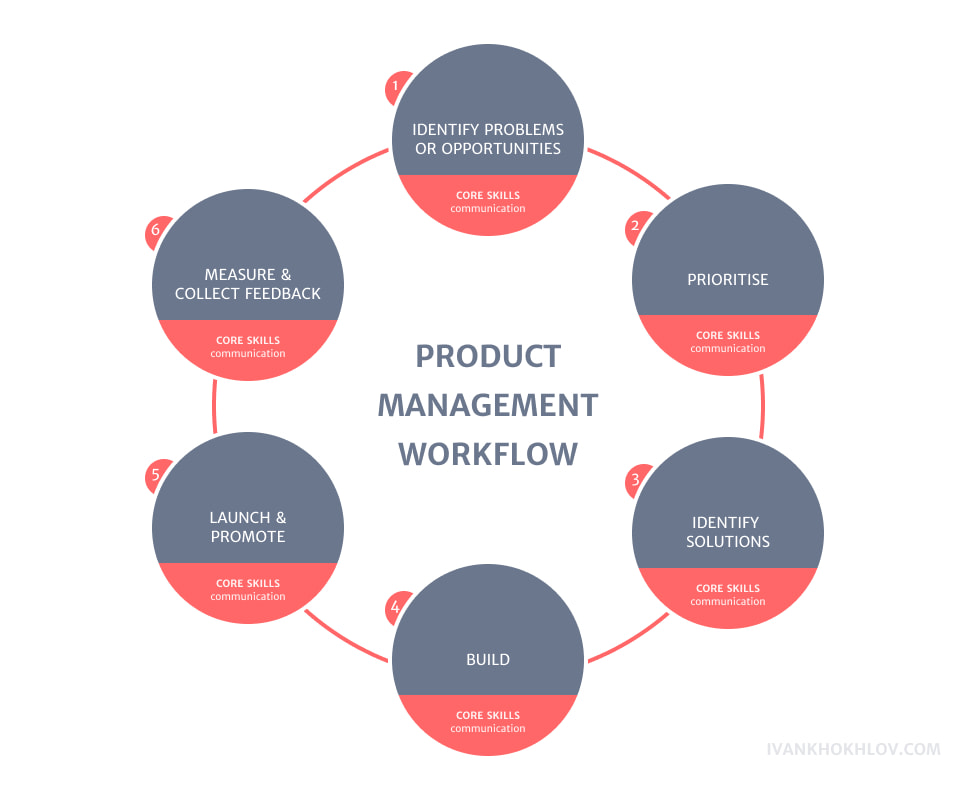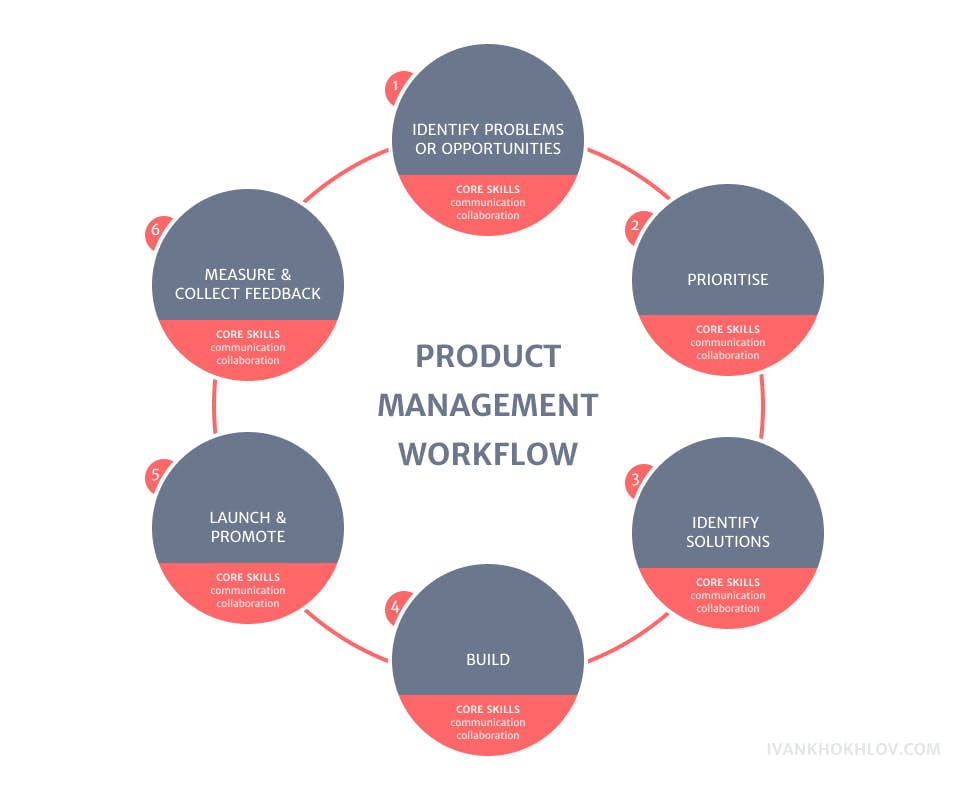Why communication and collaboration are the main product manager's skills
Communication and collaboration are the two most important skills a product manager can have. They will help any product manager succeed accross the 6 phases of product management.

This is a work-in-progress article.
Check out part one of this article series for an introduction to the product management workflow .
The product manager's workflow consists 6 core phases (see below). During each phase as a product manager you'll have a very different set of tasks which you need to accomplish. In order to complete these tasks you'll need to have the right skills.

Each phase of building a feature or a full product requires some sort of specialist skill in order to complete it fast and with high quality. Here are a few examples of specialist skills from each phase:
- Identify problems or opportunities → Business knowledge, Analytics
- Prioritise → Product intuition, Story telling (Communication)
- Identify solutions → Design, UX research, Engineering
- Build → Engineering
- Launch & Promote → Marketing
- Measure & Collect Feedback → Analytics, User Research
Obviously you cannot be a specialist in all these domains. However, there are two skills which are critical to your success at every phase: communication and collaboration . Knowing how to work well with others and communicate are probably the two most underestimated skills which exist, especially in product management.
As a product manager you will not succeed unless you become a master communicator and collaborator. You rarely have the luxury (unless you are a product director or CPO) of people reporting to you. This means you never "order" people around. Your job is to orchestrate a solution to a business problem by engaging through friendly collaboration with many individuals across the business.
Nevertheless, before we dive deeper into communication and collaboration it's important to understand that there are a few very strong complementary specialist skills for product managers. These enable you to do something on your own without having to always rely on other people / teams which can substantially accelerate your workflow. For example if you have good analytical skills (e.g. SQL) you'll probably be able to analyse complex user behaviour patterns on your own, or measure the performance of the features your team is releasing. All without waiting for support from other teams or individuals which can be slow or difficult to obtain depending on your circumstances.
Let's now talk about communication and collaboration .
Communication as part your product management workflow
During each stage of your product lifecycle you are always communicating. This might be in the form of short updates, user conversations, internal prioritisation discussions, strategy presentations, etc. Communication is therefore at the very heart of what you do as a product manager no matter at which stage you are.
Before going further, let's attach your core skills to the workflow for a better representation:

What are you communicating at each phase?
1. Identify problems or opportunities
- Conversations with users about their problems
- Conversations with business stakeholders to get their perspective on problems
2. Prioritise
- Product strategy presentations and discussions
- Alignment discussions between product teams
3. Identify solutions
- Aligning product strategy with team goals
- Conversations with designers and engineers about solutions
- Running design sprints
- Gathering feedback from external users
- Gathering feedback from internal business stakeholders
- Updating the business on proposed solutions
4. Build
- Updating the business / other teams about progress
- Technical discussions with the engineering teams
5. Launch and promote
- Communicating updates to your users
- Aligning with marketing about promotion strategies
- Updating the business about launches and promotion strategies
6. Measure and collect feedback
- Engaging with the analytics teams to understand the impact of your work and maybe build some product dashboards
- Updating the business about the impact of your product or feature
- Talking to users to collect feedback
These are just a few examples. There are dozens more.
The reality is that you rarely have the luxury to only be communicating at one particular stage. Very often, even within a single day, you might end up having to create communication streams to various people across various functions. In some cases it might be related to newly discovered problems. In other cases, it might be the need to align with another product team.
One thing is certain: communication is energy draining and often requires you to step out of your comfort zone. Great communication requires years of practice and it's probably one of the hardest skills to master. If you can't do that or are unwilling to learn, then product management may not be for you.
Communication becomes a lot easier if the people you are engaging with know you, and trust you. This is why one of your highest priorities as a product management is to build trust with the stakeholders which matter the most to you. Building trust requires time and I would encourage every product manager to make it a priority when they join a company.
Collaboration as part your product management workflow
Communication has a companion: collaboration. They often go hand-in-hand but don't make a mistake: they are different skills. You might be a great communicator, but you might not know how to work with others.
Collaboration is the other skill which over time you'll realise sits at the core of product management. Again, let's make a final amend to our diagram before we go on:

How are you collaborating in each phase?
1. Identify problems or opportunities
- Working closely with users or potential users to identify problems
- Working closely with the analytics team to dig through data
2. Prioritise
- Working closely with different stakeholders (often across the entire business) to get their "buy-in" for the prioritisation
- Or working together with these stakeholders to prioritise together
3. Identify solutions
- Working closely and creatively with designers, engineers, business stakeholders, users, etc. to come up with smart solutions to problems
4. Build
- Working closely with your engineers, data scientists, designers, etc. to actually build a solution
5. Launch and promote
- Working closely with marketing to come up with a launch and promotion plan
6. Measure and collect feedback
- Working closely with the analytics team to understand the feature performance
- Working closely with users to collect feedback
The words "Working closely with..." are probably repeated too often above but that best represents what you are doing. A product managers time roughly looks like this:
- 20% working alone
- 80% working closely with someone
Product management is not for those who want to sit alone in a bubble and do work. Yes there is some of that alone "thinking time", but in most cases you transporting yourself daily across the different phases in order to communicate and collaborate .
A few numbers
To be continued.
Let's recap what we learned
To be continued.